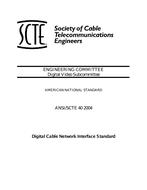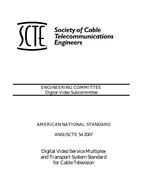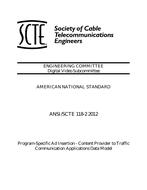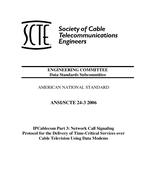Provide PDF Format
SCTE 40 2004
- Digital Cable Network Interface Standard
- standard by Society of Cable Telecommunication Engineers, 01/01/2004
- Publisher: SCTE
$25.00$50.00
This standard defines the characteristics and normative specifications for the network interfacebetween a cable television plant and commercially available consumer equipment that is used toaccess multi-channel television programming. The interface is also compatible with existing settopterminal equipment owned by cable operators and with terminal equipment developed via theOpenCable™ specification process (see www.opencable.com). In this standard the CableNetwork Interface is defined as the interface between the cable drop and the input terminals ofthe first device located on the subscriber's premises regardless of whether that device is ownedby the subscriber or the cable operator. A coaxial-based broadband access network is assumed.This may take the form of either an all-coax or hybrid-fiber/coax (HFC) network. The genericterm "cable network" is used here to cover all cases. Cable networks typically use a sharedmedium,tree-and-branch architecture with analog and/or digital transmission. The keyfunctional characteristics assumed in this document are the following:
- Two-way transmission.
- The maximum optical/electrical spacing between the cable headend and the most distantdeployed terminal equipment is 100 miles, although typical maximum separation may be10-15 miles.
- A maximum differential optical/electrical spacing between the cable headend and the closestand most distant deployed terminal equipment is 100 miles, although this would typically belimited to 15 miles.
Related Products
SCTE 54 2007
Digital Video Service Multiplex and Transport System for Cable Television..
$25.00 $50.00
SCTE 118-2 2012
Program-Specific Ad Insertion - Content Provider to Traffic Communication Applications Data Model..
$25.00 $50.00
SCTE 24-3 2006
IPCablecom Part 3: Network Call Signaling Protocol for the Delivery of Time-Critical Services over C..
$25.00 $50.00





